
1. Mass LEGAL Immigration In Canada
Despite what many think, LEGAL immigration into Canada is actually a much larger threat than illegal aliens, given the true scale of the replacement that is happening. What was founded as a European (British) colony is becoming unrecognizable due to forced demographic changes. There are also social, economic, environmental and voting changes to consider. See this Canadian series, and the UN programs for more detail. Politicians, the media, and so-called “experts” have no interest in coming clean on this.
CLICK HERE, for UN Genocide Prevention/Punishment Convention.
CLICK HERE, for Barcelona Declaration & Kalergi Plan.
CLICK HERE, for UN Kalergi Plan (population replacement).
CLICK HERE, for UN replacement efforts since 1974.
CLICK HERE, for tracing steps of UN replacement agenda.
Note: If there are errors in calculating the totals, please speak up. Information is of no use to the public if it isn’t accurate.
2. Annual Immigration Reports To Parliament
2004.annual.immigration.report.to.parliament
2005.annual.immigration.report.to.parliament
2006.annual.immigration.report.to.parliament
2007.annual.immigration.report.to.parliament
2008.annual.immigration.report.to.parliament
2009.annual.immigration.report.to.parliament
2010.annual.immigration.report.to.parliament
2011.annual.immigration.report.to.parliament
2012.annual.immigration.report.to.parliament
2013.annual.immigration.report.to.parliament
2014.annual.immigration.report.to.parliament
2015.annual.immigration.report.to.parliament
2016.annual.immigration.report.to.parliament
2017.annual.immigration.report.to.parliament
2018.annual.immigration.report.to.parliament
2019.annual.immigration.report.to.parliament
3. Context For This Article
It has been covered before about the problems that immigration bring related to cultural incompatibility. Importing large numbers of very different people — year after year — leads to balkanization and fragmentation of a society. Indeed, multiculturalism is a complete lie. It never works.
However, this article focuses on the economic harm that immigration brings to Western nations. The claims that globalist politicians and businesses make don’t stand up any level of scrutiny.
4. TFW Program Used To Lower Wages
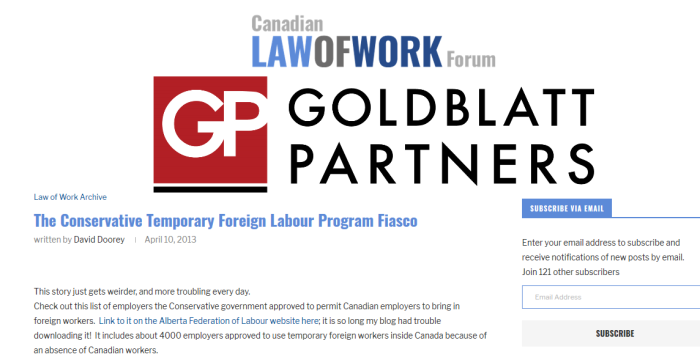
These are supposed to be extraordinary permits available to fill an immediate need for skilled workers when there just aren’t any Canadians available. However, a quick look at the list demonstrates that most of the jobs are in the fast food and service sector. According to the Conservatives, Canada has a chronic shortness of short order cooks, pizza makers, and retail and bank workers. All the major banks are on the list, along with most of the big retailers like Walmart, Sears, and Gap. Almost every university in Canada is on the list too, for some reason. Is the program used to bring in foreign academics? Not sure. The National Post is there, as is many divisions of Rogers’ Communications. Think of a company that operates in Canada, and there’s a good chance they have used foreign workers under the Tory scheme.
The Conservatives allow employers to pay the foreign workers 15% less than the average market rate. This incentivizes the use of foreign workers over Canadian workers. I can offer no explanation as to why our government thinks that is good economic policy
This was widely reported in 2013, that the Temporary Foreign Worker Program is being used like this since it offers employers financial incentives to hire foreigners over Canadians.
Let’s start with a simple concept in economics: supply and demand. When there is a high supply of something, there will be a relatively low demand for it, which can drop prices. Inversely, having a lower demand will raise the demand for it, thus raising the prices.
Now take that concept and apply it to employment. The supply here is the amount of workers available, and the demand being a price of their labour (wages). When an area, or even just an industry, is oversaturated with potential workers, it becomes an employer’s market. Companies are able to get people to work for less money and little or no benefits, since their is a surplus of workers to choose from. However, when there is no surplus of workers — or just a small one — workers are better able to secure higher wages and better provide for families.
5. Jason Kenney’s Duplicitous TFW “Reductions”
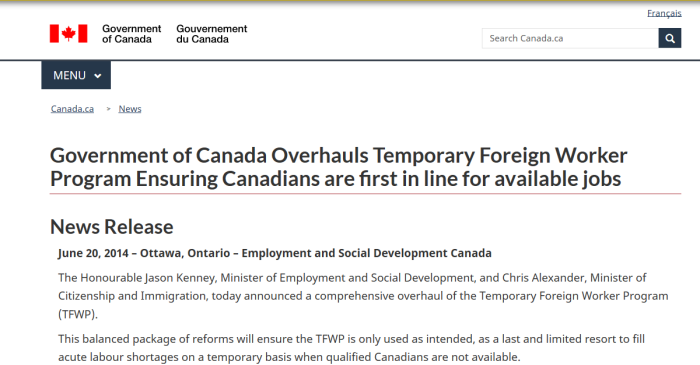
To offer greater clarity and transparency, the current TFWP is being reorganized and new International Mobility Programs (IMPs) are being created. The TFWP will now refer to those streams under which foreign workers enter Canada at the request of employers following approval through a new Labour Market Impact Assessment (LMIA). The new IMPs will incorporate those streams in which foreign nationals are not subject to an LMIA, and whose primary objective is to advance Canada’s broad economic and cultural national interest, rather than filling particular jobs. These reorganized programs will improve accountability, with Employment and Social Development Canada (ESDC) being the lead department for the TFWP, and Citizenship and Immigration Canada (CIC) the lead department for the IMPs. In addition, ESDC will publicly post data on the number of positions for temporary foreign workers approved through the TFWP on a quarterly basis, and will post the names of corporations that receive permission to hire temporary foreign workers through LMIAs.
The Government here is being extremely disingenuous about the “reduction” of temporary foreign workers being allowed into Canada. In response to public outrage about the size and scale of the Temporary Foreign Worker Program, then Immigration Minister Jason Kenney promised to fix it.
However, these “fixes” resulted in the International Mobility Program being vastly expanded while the TFWP was shrunk. The actual number of temporary workers remained about the same.
Side note: True North’s Candice Malcolm and Kasra Nejatian were both staffers for Kenney while this was happening.
6. Students Used To Drive Down Wages

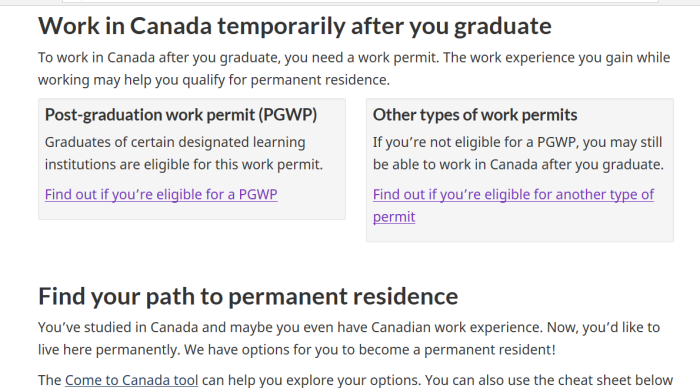
| Year | Stu | TFWP | IMP | Total | |
|---|---|---|---|---|---|
| 2003 | 61,293 | 82,151 | – | 143,444 | |
| 2004 | 56,536 | 90,668 | – | 147,204 | |
| 2005 | 57,476 | 99,146 | – | 156,622 | |
| 2006 | 61,703 | 112,658 | – | 174,361 | |
| 2007 | 64,636 | 165,198 | – | 229,834 | |
| 2008 | 79,509 | 192,519 | – | 272,028 | |
| 2009 | 85,140 | 178,478 | – | 263,618 | |
| 2010 | 96,157 | 182,276 | – | 278,433 | |
| 2011 | 98,383 | 190,842 | – | 289,225 | |
| 2012 | 104,810 | 213,573 | – | 318,383 | |
| 2013 | 111,865 | 221,310 | – | 333,175 | |
| 2014 | 127,698 | 95,086 | 197,924 | 420,078 | |
| 2015 | 219,143 | 73,016 | 175,967 | 468,126 | |
| 2016 | 265,111 | 78,402 | 207,829 | 551,342 | |
| 2017 | 317,328 | 78,788 | 224,033 | 620,149 | |
| 2018 | 356,876 | 84,229 | 255,034 | 696,139 |
For some context: Canada went from admitting 60,000 student visas in 2003 to almost 360,000 in 2018. That is nearly 6 times as large over a 15 year span. Additionally, we went from about 80,000 temporary work visas in 2003 to over 320,000 (TFWP and IMP combined) in 2018.
Students are allowed to work 20 hours per week when school is in session, and an unlimited number of hours otherwise. Although there were once restrictions on where students could work, that is not the case anymore. The student visa effectively doubles as an open work permit.
Two other points to note: first is that student visas can be extended under a variety of circumstances. So that 2 year visa for a college program, or 4 year visa for a university degree may go longer.
Second, there are a variety of options to stay longer in Canada. There are the Provincial Nominee Programs, and various pilot programs. But the big one is the Post Graduate Work Program, which offers a 3 year open work permit to graduates. Of course that 3 year visa can be extended in some cases.
7. New Graduates Can’t Find Work in Field
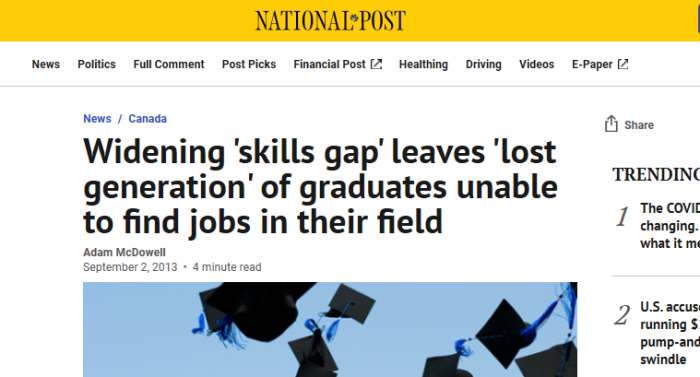
In the absence of reliable data, labour market experts encourage students to do their own research in fields they’re interested in, paying special attention to where those jobs are located. (The Canadian Chamber of Commerce forecasts thousands of job openings by the end of the decade in mining, construction, trucking, food processing and tourism. The health-care field, meanwhile, is full of promising careers.)
Research is important because colleges and universities don’t typically warn students about a program’s poor job outlook before they enrol. And while many post-secondary programs try to match their enrolment numbers to real opportunities, others blindly offer a similar number of places year after year. Some observers question why hundreds of students are still accepted annually into programs in journalism, for example, a field that is eliminating rather than creating jobs.
Depending on the source of information, other programs with poor prospects may also include biology and certain manufacturing-related trades. Contrary to conventional wisdom, the trades are not promising across the board: Carpenters, for example, are an “occupation in excess supply,” at least according to federal data. Even law, a perennial destination for seekers of high salaries, is getting too crowded: Canadian Lawyer magazine reported in December that between 10% and 15% of qualified law school graduates, or some 400 a year, cannot find articling positions after graduation.
This National Post article is from 2013, but the same issues are still present today, just more pronounced. If specialised fields are already saturated, and Canadian graduates cannot get meaningful work, then how does bringing in many more foreign graduates make their situation any better?
8. High Skill Workers Being Replaced

If large numbers of recent graduates can’t find work in their fields, one has to reasonably ask what is the purpose of importing so-called skilled workers. Are we really unable to find doctors, nurses, accountants, engineers, scientists, trades workers, or computer programmers? Are Canadian colleges and universities turning out hundreds of thousands of grads who are completely useless? In that case, why are we accepting so many foreign students if our education system is such garbage?
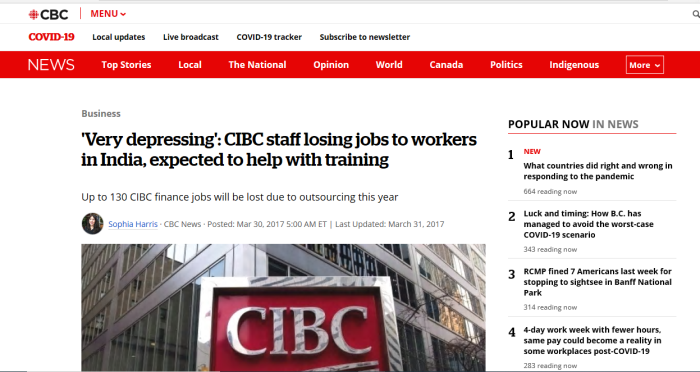
This is again a case of supply and demand. By flooding the country with a high supply of foreign labour, the relative demand for the work gets driven down. Consequently, it puts downward pressure on wages.
Talking heads frequently tout immigration as a solution to filling “the jobs that Canadians don’t want to do”. However, it is also used for the type of work that is considered professional or skilled or semi-skilled. Mass migration advocates care little — if at all — at the societal impacts of flooding the market.
9. Low Skill Workers Being Replaced
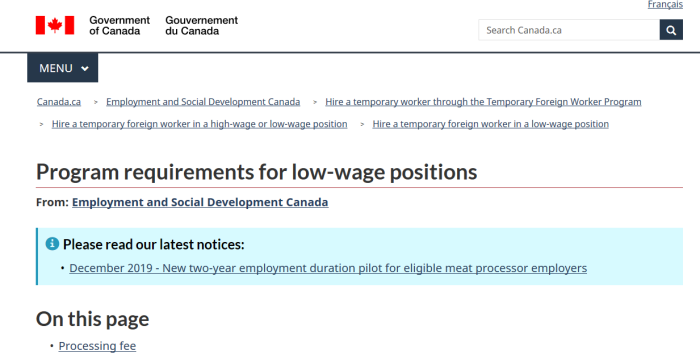
While immigration advocates play down how they try to import a replacement work force for high skilled work, they are quite open about using it to fill low-skill, low-wage work. This of course includes restaurants, retail, grocery stores, agriculture and similar work.
What about young Canadians looking to find work for the first time? What about older ones who don’t have any specialization or skill? What happens to them? Are they now forced to compete with foreigners who are often willing to work for less? Does this become a race to the bottom for wages and benefits?
10. Work Permits For Illegals
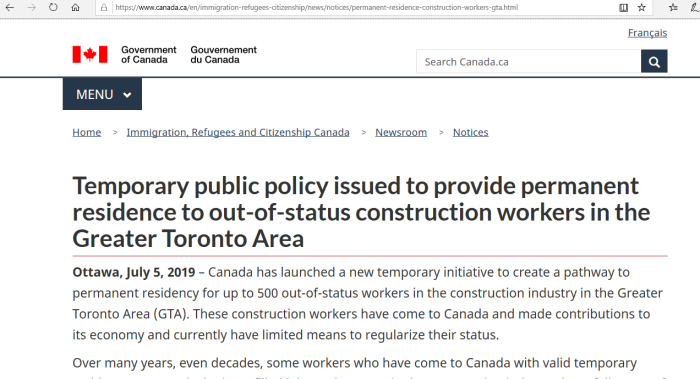
There are a number of cases to point out, but let’s just to name a few here. First, there are several sanctuary cities in Canada which allow illegal aliens to work and receive social services — despite being in the country illegally. Second, Toronto started a pilot program in 2019 to give 500 workers, and their families, a pathway to permanent residence and citizenship if they would work in construction in the GTA. Third, our politicians seem to have no real concern with expediting health benefits and work permits for people entering the country illegally.
People working illegally also have the effect of further driving down wages for Canadians. How so? Because without a right to work legally, many will work under the table but for far less than a legal resident. This means jobs that could have been done by locals are scooped up and removed from the pool.
11. Pathways To Remaining In Canada
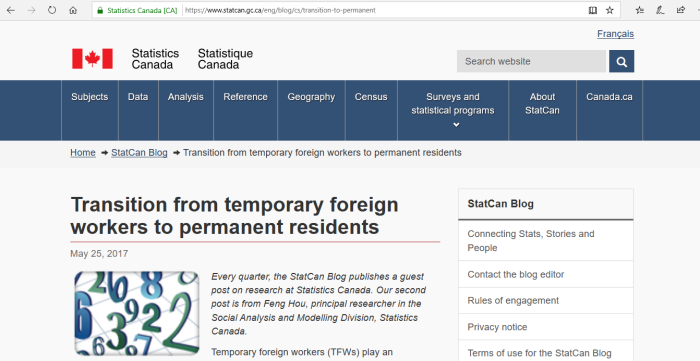
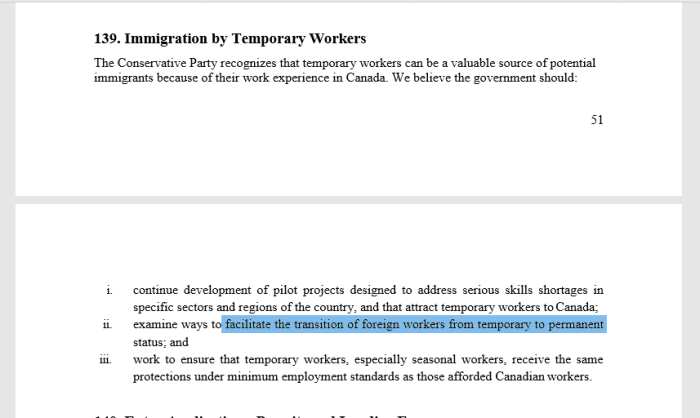
This has been addressed in other articles, but there are many paths for “temporary” migrants to remain in Canada. The typical Canadian has no idea. Globalist mainstream parties open advocate for the PR pipeline that undermines our sovereignty.
12. Immigration To High Unemployment Areas
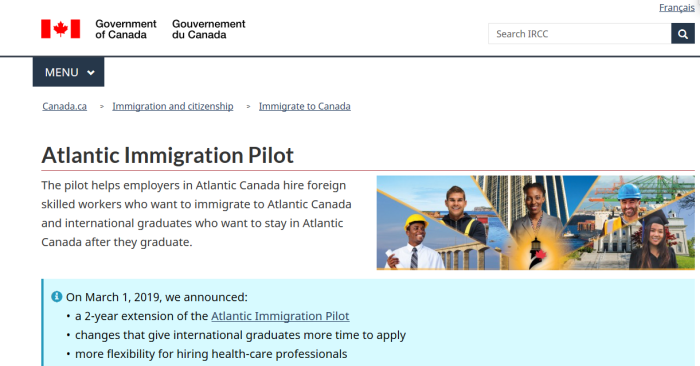
The Maritimes Region of Canada encompasses Nova Scotia, New Brunswick, Newfoundland & Labrador, and Prince Edward Island. These Provinces routinely have high unemployment, with people claiming that there is little to no work available around.
If this were true, why in the world would we need specific programs like the Atlantic Immigration Pilot Program to specifically target this region? Wouldn’t putting locals to work first be the much better option?
Or is this just an excuse to flood the region with cheap replacement labour and ultimately replace the population?
13. Remittances Draining National Coffers
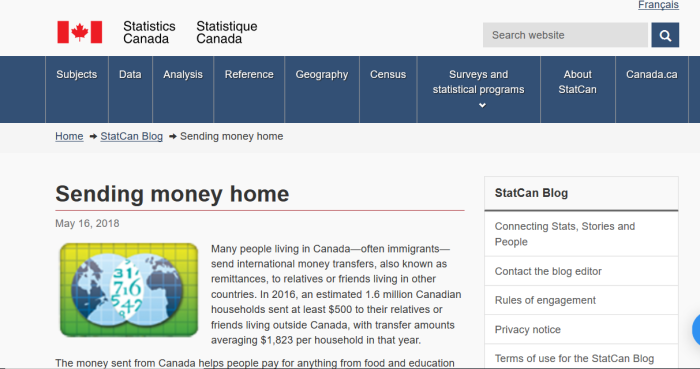
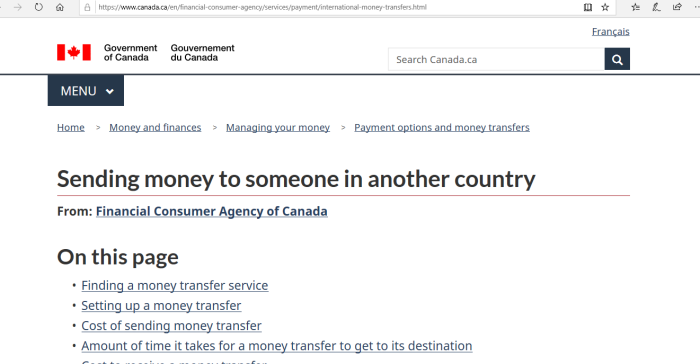
The Vancouver Sun reported on World Bank estimates that in 2012, Canada sent approximately $24 billion out of the country. That’s right, economic immigration cost Canada $24 billion. More recent estimates have been $25 billion in 2017 and $28 billion in 2018. Keep in mind these are just estimates and nowhere near exact.

CLICK HERE, for World Bank, remittances in 2013.
CLICK HERE, for World Bank, remittances in 2015.
CLICK HERE, for World Bank, remittances in 2016.
CLICK HERE, for World Bank, remittances in 2017.
CLICK HERE, for World Bank, remittances in 2018.
Global Remittances In Recent Years
| Year | Total ($B) | To 1st World | To 3rd World | Diff. |
|---|---|---|---|---|
| 2013 | $581B | $177B | $404B | $227B |
| 2014 | $592B | $162B | $430B | $268B |
| 2015 | $582B | $142B | $440B | $298B |
| 2016 | $573B | $144B | $429B | $285B |
| 2017 | $613B | $147B | $466B | $319B |
| 2018 | $689B | $161B | $528B | $367B |
Hundreds of billions of dollars are sent abroad annually. The bulk of it is money being sent from the 1st World back to the 3rd. Far from immigration (temporary or permanent), being a boon for the local economy, it results in huge amounts of money being drained. Yet advocates for mass migration routinely leave this detail out.
14. Burden On Social Services
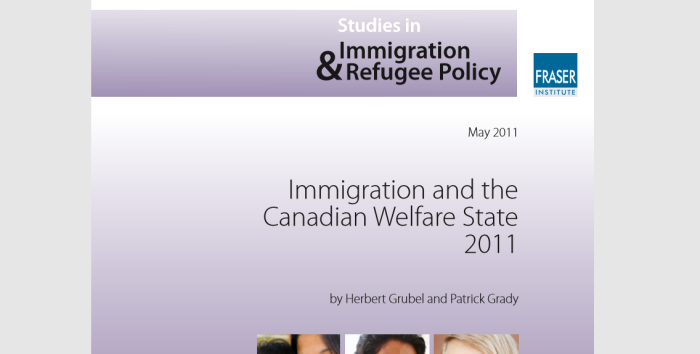
immigration-and-the-canadian-welfare-state-2011
I’m a bit hesitant to use this, given that Fraser Institute is part of Atlas Network, and heavily Koch funded. Nonetheless, it does get into the overall burden that immigration has consistently had, at a net loss of several thousand dollars per person. Worth a read.
We propose changes in Canada’s immigrant selection process that are not anti-immigrant, but are instead aimed at replacing the present failed system with one that uses market forces to select immigrants and thus to determine the level of annual inflows. The basic instrument proposed for the selection of immigrants is reliance on legitimate job offers issued by approved Canadian employers. This private system is to be supervised by the government to ensure those immigrants’ earnings are high enough to prevent the imposition of fiscal burdens and that immigrants do not pose a risk to public health and safety.
In other words, the Fraser report has no problems with importing a replacement population, but would rather it be one of high skilled people in order to offset increased strain on social services. Never mind what the added supply of workers would do to average wages overall.
It points out that family reunification is essentially a humanitarian gesture with no real economic benefit, which is true. However, the focus solely on benefits v.s. costs comes across as rather cold.
15. Brain Drain From Developing Nations

From 2003 to 2013, the number of scientists and engineers residing in the US grew from 21.6 million to 29 million. An important factor in this growth has been immigration. In 2013, 18% (5.2 million) of the scientists and engineers residing in the United States were immigrants whereas in 2003, 16% (3.4 million) were immigrants.
The most common broad fields of study for immigrant scientists and engineers in 2013 were engineering, computer and mathematical sciences, and social and related sciences.
“India’s huge population of talented youth means that we have enough young minds who can contribute to India from India and to India from outside India. We must continue to develop more excellent institutions and opportunities here so that the best have avenues here and not only abroad. This development of excellence is indeed happening,” Vijay Raghavan, secretary department of biotechnology, told HT.
RA Mashelkar, former director general, CSIR, said: “We need to create an environment in which innovation flourishes. Otherwise the innovators will either play safe and not innovate, or they will leave to become a part of other societies, which encourage innovation.”
He said, “A fraction of the scientists and engineers are returning. Assuming 15% of them are the ones that have come back, it is just 30,000. May be 20,000 have come back to new IISERs, IITs, central universities, industrial R&D centres, etc. Put together, it means less than 50,000 have come back. This is just 5% of 9,500,000 immigrants in the US.”
What we have here is a situation where people are leaving India in droves to get to the West. And this applies to many fields, not just STEM. The result is young adults turning their back on the country that raised them and making a new life. While it may be beneficial to them and their immediate families, what happens to the communities who provided education and other social services? What happens when medical professionals are trained at public expense, and then they leave the country?
Those advocating mass migration to the West rarely if ever address this point. The places that these professionals leave will be worse off, as their talent has all been lured away.
While huge influxes from India (and other nations) are serving to drive down wages in the West, it creates a shortage of talent back at home.
16. Immigration/Globalization Have Parallels
Senator Bernie Sanders was for many years a fierce opponent of bringing in large numbers of people into the U.S., and it would have the effect of depressing wages. He also made the connection between globalization (free trade), and immigration, as both tend to gut the middle class.
Although Sanders is American, the same principles apply here as well. Mass migration and free trade are devastating the middle class of Canada. CANZUK is an obvious example of a treaty that does both.


(a) In a free trade system, jobs get sent overseas to where things can be made cheaper, which will DECREASE the supply of jobs in Canada.
(b) With open immigration, people can come to Canada freely, which will INCREASE the demand for what jobs remain.
In a situation where you have many more people competing for far fewer jobs, what happens to the wages? They are driven down, and this is a policy conservative politicians in general support.
17. Inflating The Pension Ponzi Scheme
One of the reasons globalists claim that continuous immigration is needed is to fund pension plans. The reasoning goes that more workers means more money deducted for C.P.P., which means seniors can get paid.
An obvious flaw in that theory: eventually all of those workers will get old as well. That means that they will start collecting on their pension benefits. You know, the people whose deductions we took to pay off old obligations. This type of system is predicated on a permanently expanding population, which of course is not possible.
Another big problem is that the typical person receiving a pension gets nowhere near what they paid into it. Remember, employers also kick in a matching 5% contribution. And should a person die early, their heirs will receive only a small portion as a payout.
18. Spies In Canadian Universities
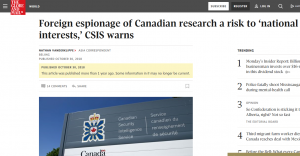
The Canadian Security Intelligence Service (CSIS) said on Tuesday that it routinely meets with universities to warn them of risks. The Globe and Mail reported this week that at least nine Canadian postsecondary institutions have conducted joint studies in recent years with researchers from Chinese military institutions, including the People’s Liberation Army Information Engineering University, China’s Air Defence College and the elite National University of Defense Technology.
In general, Canadian university policies require joint research to be published openly.
The collaborations, however, have raised concern that Canada’s academic establishment has become a target for Chinese intelligence-gathering, as Beijing conducts a sweeping technological modernization of its armed forces. Some Chinese defence scientists working with Canadian scholars have used the names of what appear to be non-existent civilian institutions rather than citing their military credentials in joint publications. Collaborative work with Canada has included advances in secure communications and satellite-image processing, technologies that have civilian and military value.
A report this week by the Australian Strategic Policy Institute found three Canadian universities among the global top 10 in publishing joint research with Chinese military scholars. The institute tabulated 687 academic papers co-authored by Canadian academics with Chinese defence researchers.
Universities said federal authorities determine which foreign researchers are allowed into Canada.
Sure, having open admissions to Canadian colleges and universities ensures a steady flow of students and of tuition dollars coming to Canada. That being said, perhaps national security should place somewhere higher up in terms of priorities.
If someone is born in China, raised in China, has extended family in China, and is ethnically Chinese, then does simply giving them a passport and immigration paperwork magically make them Canadian?
19. CV “Planned-emic” A Potential Plus
The coronavirus “planned-emic” is another large series on this site. While it clearly is a fraud designed to loot national treasuries and strip citizens of their rights, there may be a potential benefit.
Immigration as a general premise is harmful to society. The diversity causes fragmentation and balkanization, while economic immigration has many of its own downsides. A benefit in all of this would be to drastically cut immigration — permanently — if not go for an outright moratorium.
But do our leaders look towards this obvious solution while we have sky-high unemployment? No, they would have to care about their citizens.
20. Conservative Inc. Is Part Of The Problem
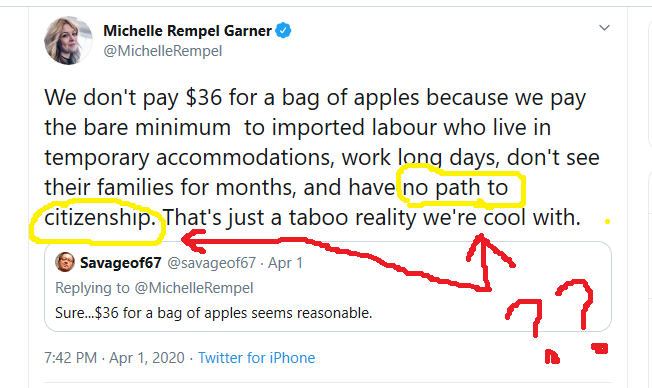


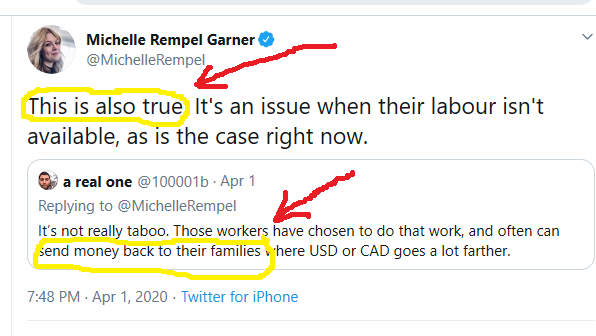
CLICK HERE, for Rempel tweet #1.
CLICK HERE, for Rempel tweet #2.
CLICK HERE, for Rempel tweet #3.
CLICK HERE, for Rempel tweet #4.
Michelle Rempel was previously the Immigration Critic in the Parliament. She doesn’t know (or at least claims to not know) that Temporary Foreign Workers have pathways to stay. It’s pretty disgusting to see that she views immigration simply as filling labour needs, which means a surplus of workers. There’s no regard for social cohesion or any of the costs to these policies.
21. Why Not Have More Canadian Children?
Obvious question, but if we truly need more people to work on farms, take both high and low skilled jobs, and to help fund pensions, why are we importing people? Why not push programs to get Canadian families having more children? Nations like Hungary do it, with great success.
Instead of importing a replacement population to fulfill these so-called economic needs, why not get larger Canadian families doing this? This will be born Canadian, and grow up Canadian. They won’t be foreigners with a visa.

Something like this perhaps. Instead of the endless problems that diversity and multiculturalism bring, have larger families within Canada. Rather than all of the economic issues with large scale immigration, raise the next generation here.

Thanks for fantastic info I was looking for this info for my mission.